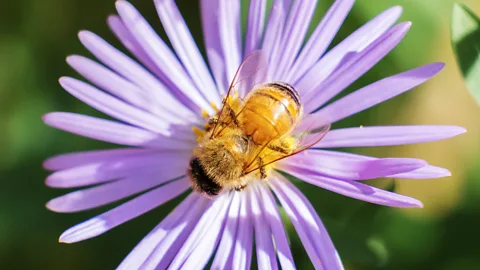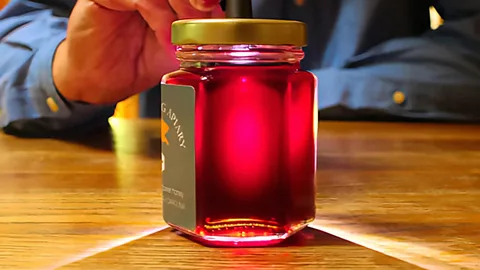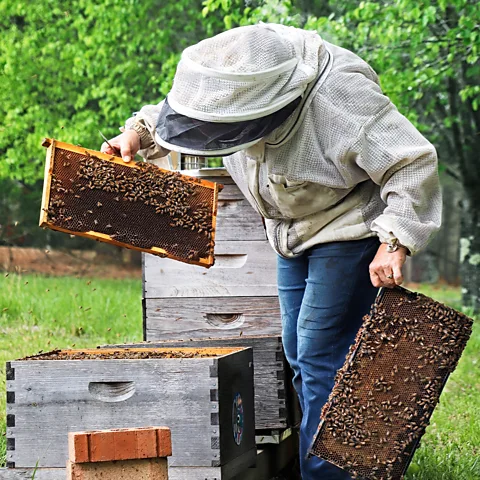The baffling purple honey found only in North Carolina
 Alamy
AlamyIn a quiet corner of North Carolina, bees produce a violet-hued honey so rare and unpredictable that even experts can't explain it – and that's what makes it magical.
In the Sandhills region of North Carolina, between the capital of Raleigh and the Nascar Hall of Fame in the sport-mad town of Charlotte, visitors may not even realise what a rare ecological niche they're stepping into. This is where the Atlantic once met the venerable Uwharrie Mountains, 145km inland; when the ocean pulled away, it left behind the grit that gave the region its name.
The region is one of the last homes for unique flora and fauna like the southern hognose snake and the Carolina gopher frog, both of which are endangered. What it's also known for, though, is something that has university researchers, foodies and conspiracy theorists all scratching their heads. It's a rare and coveted honey in a deep shade of aubergine-purple, and no one knows for sure what gives it the hue.
People largely travel to the Sandhills region for open-air adrenaline pursuits and laid-back rural charm – think corn mazes, trout fishing and country fair-style Americana.
The prestigious Pinehurst Golf Resort, commonly referred to as the "cradle of American golf", is here (don't miss its celebrated No 2 course), as is the horse riding hub Southern Pines and its abundance of equestrian trails and backcountry trekking. Kayakers and canoers flock to Drowning Creek, drawn by the scenic 13-mile route from Turnpike Road to Highway 401.
 Rusty Berlew
Rusty BerlewHunting classic Southern game like white-tailed deer, wild turkey and wood ducks is popular in these parts, with extensive land preserves designated for conservation to support the pursuit. The longleaf pine forests are themselves a thing of simple beauty, and twitchers come here to search for northern bobwhite quails, bald eagles and – the star attraction – imperilled red-cockaded woodpeckers with their binoculars.
World's Table
BBC.com's World's Table "smashes the kitchen ceiling" by changing the way the world thinks about food, through the past, present and future.
But travellers also come to the region to seek out something even more extraordinary than threatened species and unique biomes. Here, if the conditions are exactly right (a mystery even to the experts) and the timing is perfect (a secret only the bees know), apiarists will visit their hives and find not just frames brimming with a slow and sultry river of liquid gold, but perhaps one that gleams with deep violet treasure.
"It is true that nobody knows what causes purple honey," says Paige Burns, who has a degree in horticulture and works with farmers and foresters in her role as the Richmond County Extension Director. Theories abound, both of the folklore and pseudo-scientific variety, and much like a porch swing, everybody here has one.
Burns tells me a few of the more popular speculations: that it's the alkalinity of the soil changing the honey's colour as it does hydrangeas from blue to pink; that it's wild berries surrounding the bee's territory; and, the one that sparks the most vociferous debate among locals, that it's the deep violet flower of the invasive (and wildly reviled) kudzu vine. Beekeepers in the area have reported finding the jewel-hued honey in their hives for years, but even so, its appearance is so sporadic and at the whim of chance, it continues to be a surprise when it does appear.
 Getty Images
Getty ImagesDon Dees, who owns and operates Dees Bees Apiary in nearby Aberdeen, North Carolina, has purple honey on his website, but it's sold out. It's impossible to pre-sale for this year's harvest since no one knows how much, or even if, the bees will deign to colour the combs in plum or in the customary amber. Instead, he invites people to check his Facebook page for updates from mid-July. His pure raw honey costs $16.50 (£13) for 900g. Purple honey, when he has it, goes for $75 (about £58) for an 85g glass jar. Talk about finding treasure; this is a limited edition in every sense of the word.
Plan your trip
- If you’re looking to purchase your own jar of amethyst treasure, keep an eye out online for availability toward late July. Dees Bees Apiary tends to sell in smaller increments so more people have the chance to try it.
- At other times of year, drop into local shops and farmers' markets to taste the distinct honey varieties grown here, from sourwood to apple blossom to tupelo, and if you’re lucky, some of the purple stuff, too.
- Visitors can also take a honey tour with Honeybee Bliss, where suited-up guests play honey sommelier and take a turn at pulling bee-laden frames oozing with golden goo.
Dees' take on the phenomenon? He refutes the lore that aluminium in the terrain plays a factor and insists that kudzu isn't part of the equation, reasoning his apiary would produce it every season if so. Purple honey is most likely to arise under drought-like conditions, he says, and Dees believes that blue-black huckleberries that grow on shrubs rooted in thirst-tolerant clay feed the hard-up-for-food bees that can't locate traditional more water-dependent blooms.
However, Rusty Burlew, a master beekeeper who directs the Native Bee Conservancy of Washington State, says that a lot of circumstantial evidence points to the inky-violet flower of the kudzu, and she doubts that bees have the jaws necessary to pierce fruit for nectar. Flavour-wise, she says, "to my untrained palate, the honey really does taste purple, in a grape-y sort of way".
 Courtesy of Matt Lawrence/ Hawfield's Honey House
Courtesy of Matt Lawrence/ Hawfield's Honey HouseBurns tells me that she's never been one of the lucky ones to harvest the jammy-sweet treasure. "One of the beekeepers I work with, she's probably, as the crow flies, two miles from me. I'm on the creek; she's on the creek. Obviously, we're in a very similar environment. She regularly gets purple honey; I've never gotten it." Laughing, she adds that it's a surprise even to the bee farmers when they open the hive and find it. "Some years you get it, and then 10 years you don't."
More like this:
• The unexpected origins of Houston's favourite po' boy
And here I am, a native to the state, with no idea such a wild-foraged wonder existed. Turns out some mysteries aren't just hidden; they're hidden in plain sight. That's the beauty of travel: not just the landscapes that render you speechless or the food that rewrites the rules, but the stories you stumble into along the way. The ones that don't come with tidy explanations or easy answers. There aren't many of those left.
There's something incredible about standing under a sky unbothered by city lights, surrounded by the literal hum of a place still untamed, knowing that not even the beekeepers – who spend their days elbow-deep in the stuff – can tell you why this honey defies nature's colour wheel. Maybe we'll never know. And perhaps that's the point. Some places keep their secrets – and that's precisely what makes them worth the trip.
--
If you liked this story, sign up for The Essential List newsletter – a handpicked selection of features, videos and can't-miss news, delivered to your inbox twice a week.
